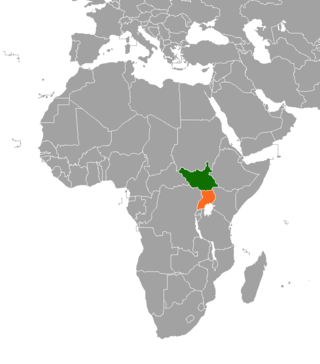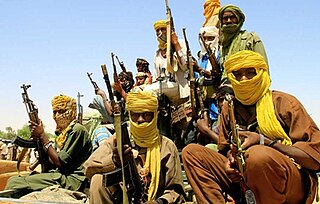
Salva Kiir Mayardit, commonly known as Salva Kiir, is a South Sudanese politician who has been the President of South Sudan since its independence on 9 July 2011. Prior to independence, he was the President of the Government of Southern Sudan, as well as First Vice President of Sudan, from 2005 to 2011. He was named Commander-in-Chief of the Sudan People's Liberation Army (SPLA) in 2005, following the death of John Garang.

The War in Darfur, also nicknamed the Land Cruiser War, was a major armed conflict in the Darfur region of Sudan that began in February 2003 when the Sudan Liberation Movement (SLM) and the Justice and Equality Movement (JEM) rebel groups began fighting against the government of Sudan, which they accused of oppressing Darfur's non-Arab population. The government responded to attacks by carrying out a campaign of ethnic cleansing against Darfur's non-Arabs. This resulted in the death of hundreds of thousands of civilians and the indictment of Sudan's president, Omar al-Bashir, for genocide, war crimes, and crimes against humanity by the International Criminal Court.
Heglig, or Panthou, is a small town at the border between the South Kordofan state of Sudan and the Unity State in South Sudan. The entirety of Heglig is claimed by both Sudan and South Sudan, but administered by Sudan. The area was contested during the Sudanese Civil War. In mid-April 2012, South Sudan's Sudan People's Liberation Army (SPLA) captured the Heglig oil field from Sudan. Sudan took it back at the Second Battle of Heglig ten days later.

The 2001 Bangladesh–India border clashes were a series of armed skirmishes between India and Bangladesh in April 2001. The clashes took place between troops of the Bangladesh Rifles (BDR) and the Indian Border Security Force (BSF) on the poorly-marked international border between the two countries.

The Abyei Area is an area of 10,546 km2 or 4,072 sq mi on the border between South Sudan and Sudan that has been accorded "special administrative status" by the 2004 Protocol on the Resolution of the Abyei Conflict in the Comprehensive Peace Agreement (CPA) that ended the Second Sudanese Civil War. The capital of the Abyei Area is Abyei Town. Under the terms of the Abyei Protocol, the Abyei Area is considered, on an interim basis, to be simultaneously part of both the Republic of South Sudan and Republic of Sudan, effectively a condominium.

Sudanese nomadic conflicts are non-state conflicts between rival nomadic tribes taking place in the territory of Sudan and, since 2011, South Sudan. Conflict between nomadic tribes in Sudan is common, with fights breaking out over scarce resources, including grazing land, cattle and drinking water. Some of the tribes involved in these clashes have been the Messiria, Maalia, Rizeigat and Bani Hussein Arabic tribes inhabiting Darfur and West Kordofan, and the Dinka, Nuer and Murle African ethnic groups inhabiting South Sudan. Conflicts have been fueled by other major wars taking place in the same regions, in particular the Second Sudanese Civil War, the War in Darfur and the Sudanese conflict in South Kordofan and Blue Nile.

South Sudan and Uganda are neighboring states with strong cultural economic and political ties. The South Sudan and the neighbouring state of Uganda enjoy relatively strong cultural, political, and economic ties. As South Sudan neared independence, both states begun to take advantage of increased opportunities for trade, development and educational exchanges. The rebel group Lord's Resistance Army (LRA), however, continues to operate in the border areas between South Sudan, the Democratic Republic of Congo and Uganda.

The Sudanese conflict in South Kordofan and Blue Nile was an armed conflict in the Sudanese states of South Kordofan and Blue Nile between the Sudanese Armed Forces (SAF) and the Sudan People's Liberation Movement–North (SPLM-N), a northern affiliate of the Sudan People's Liberation Movement (SPLM) in South Sudan. After some years of relative calm following the 2005 agreement which ended the second Sudanese civil war between the Sudanese government and SPLM rebels, fighting broke out again in the lead-up to South Sudan independence on 9 July 2011, starting in South Kordofan on 5 June and spreading to the neighboring Blue Nile state in September. SPLM-N, splitting from newly independent SPLM, took up arms against the inclusion of the two southern states in Sudan with no popular consultation and against the lack of democratic elections. The conflict is intertwined with the War in Darfur, since in November 2011 SPLM-N established a loose alliance with Darfuri rebels, called Sudan Revolutionary Front (SRF).
The history of South Sudan comprises the history of the territory of present-day South Sudan and the peoples inhabiting the region.

Bilateral relations between South Sudan and the Sudan were officially started on 9 July 2011 following South Sudan's independence. Sudan became the first country in the world to recognize the independence of South Sudan. However, relations between South Sudan and Sudan have still been poor, with both sides supporting rebel groups in the other's territory.
Ethnic violence in South Sudan has a long history among South Sudan's varied ethnic groups. South Sudan has 64 tribes with the largest being the Dinka, who constitute about 35% of the population and predominate in government. The second largest are the Nuers. Conflict is often aggravated among nomadic groups over the issue of cattle and grazing land and is part of the wider Sudanese nomadic conflicts.

The Heglig Crisis was a brief war fought between the countries of Sudan and South Sudan in 2012 over oil-rich regions between South Sudan's Unity and Sudan's South Kordofan states. South Sudan invaded and briefly occupied the small border town of Heglig before being pushed back by the Sudanese army. Small-scale clashes continued until an agreement on borders and natural resources was signed on 26 September, resolving most aspects of the conflict.
The Second Battle of Heglig was an armed confrontation of the 2012 South Sudan-Sudan border conflict that broke out on 10 April 2012.
The First Battle of Heglig was a military campaign of South Sudan that gave rise to the 2012 South Sudan–Sudan border conflict.
The air campaign of the Heglig Crisis was a military air campaign of the Sudanese Government against the Republic of South Sudan during the Heglig Crisis.

The South Sudanese Civil War was a multi-sided civil war in South Sudan fought from 2013 to 2020, between forces of the government and opposition forces. The Civil War caused rampant human rights abuses, including forced displacement, ethnic massacres, and killings of journalists by various parties. Since its end South Sudan has been governed by a coalition formed by leaders of the former warring factions, Salva Kiir Mayardit and Riek Machar. In 2024, the country continues to recover from the war while experiencing ongoing and systemic ethnic violence.
Mathiang Anyoor, also spelled Mathiang Anyur, also known as Dot Ke Beny, is a Dinka-affiliated militia group in South Sudan. Originally an ad-hoc volunteer force founded in 2012, the militia was transformed into a private army to protect President Salva Kiir Mayardit and army chief Paul Malong Awan. However, the South Sudanese military (SPLA) claims that it is just another battalion. Much of the ethnic violence against non-Dinkas in the South Sudanese Civil War is attributed to the militia.

The Al-Fashaga conflict was a conflict between Sudan and Amhara militants from Ethiopia in the disputed border region of al-Fashaga. Since 2008, Ethiopia has dropped all claims to the al-Fashaga as long as Sudan allowed Ethiopian farmers and militants to stay in the area undisturbed. With the outbreak of the Tigray War, Sudanese forces were able to move into the region due to an agreement with Ethiopia just three days before. When Amhara militants left to assist the federal government in the war, Sudanese forces started to drive out Ethiopian farmers, effectively breaking the 2008 compromise. Ethiopia has also accused Sudan of killing Amhara farmers. The Government of Sudan claims the involvement of ENDF and Eritrean troops in the border dispute while the Ethiopian government denies this and regards the conflict as skirmishes between Sudanese forces and ethnic militias from the Amhara region. External media coverage has tended to conflate the Amhara militias with federal soldiers from the Ethiopian National Defence Forces (ENDF). There is some evidence to suggest that the ENDF has been involved in the conflict, although the capacity in which they are doing so is unclear. It is likely that they have had a peripheral role in the actual fighting.
Events in the year 2021 in Sudan.
The spillover of the Tigray war has had an impact on other countries in the surrounding region, particularly in Sudan. This spillover mainly consisted of Ethiopian refugees, more than 50,000 of which have crossed the Ethiopia–Sudan border. There have also been border clashes, mostly between the Sudanese Armed Forces and Ethiopian militias, but the Sudanese government has also claimed ambushes by the Ethiopian National Defense Force have taken place. Most of the fighting centered in Al-Fashaqa, a fertile plain claimed by both Sudan and Ethiopia.









